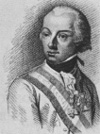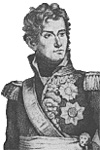 Aspern-Essling marks the return of the NBS to active publication. Using the same rules as Marengo, Aspern-Essling will not introduce radical new concepts to the series, but will bring a great deal of fun in a hard-fought slugging match between Napoleon and the man who might well have been his greatest adversary, the Archduke Charles (at right) of Austria.
Aspern-Essling marks the return of the NBS to active publication. Using the same rules as Marengo, Aspern-Essling will not introduce radical new concepts to the series, but will bring a great deal of fun in a hard-fought slugging match between Napoleon and the man who might well have been his greatest adversary, the Archduke Charles (at right) of Austria.
The Campaign
Aspern-Essling falls into that large category of Napoleonic battles that, not being of the first tier of name-recognition, often leave the casual observer scratching his head and trying to recall just what the whole thing was about. Aspern-Essling was in fact one of three or four major battles of the 1809 Danube campaign, which culminated in the massive battle of Wagram. Aspern-Essling, however, might best be defined as the Emperor of France's first clear-cut defeat.
In the spring of 1809, against the advice of Charles, the Austrian Empire was motivated to declare war on France, seeking revenge for past defeats, return of lost territories, and to take advantage of the current entanglement of French troops in Spain. In the end, the war went badly for the Austrians, but it was much less a sure thing for the French than the dazzling victories of 1805 and 1806 had been.
The initial stages of the campaign were fought out along the upper Danube, with an initial Austrian advance. Charles began his advance on April 9th, at least a week before Napoleon expected him too, and without a formal declaration of war that might have tipped his hand. The result was a great deal of initial Austrian success. Napoleon was in fact not present yet, leaving nominal command of the army to his chief of staff, Berthier, who proved to be far beyond his depth in army command.
Hurriedly, the Emperor rushed to the front and assumed command in person, gathering in the scattered elements of his army and switching over to the offensive to restore the balance. The key moment of the campaign arrived the week of April 22nd, when in a series of sharp engagements over five days, Napoleon defeated the Austrians and reversed their initial successes. This period of action resulted in two other major battles: Abensberg and Eckmuhl, where Napoleon hoped to trap Charles' army against the Danube. Unfortunately for the Emperor's scheme of maneuver, the French garrison at Ratisbon surrendered sooner than expected, opening a retreat route for Charles across the Danube to the north, and preventing complete victory.
Still, Charles was defeated, and the roles reversed. Now it was Napoleon who was about to attack down the Danube towards Vienna. After Eckmuhl Charles himself wrote the Austrian Emperor, Francis, saying, 'If we have another engagement such as this I shall have no army left. I am awaiting negotiations.' Unfortunately for Austria, Napoleon was only interested in negotiating from strength, and that meant more battlefield victories first.
Charles and the main Austrian army had retreated northeast, into Bohemia, leaving the route to Vienna largely unguarded. Napoleon, eschewing a direct pursuit, instead decided to move on the Austrian capital directly, which would force Charles to march to defend it, and also hopefully relieve pressure on the Italian front, where Austrian Archduke John was making significant headway against French forces there.
Early May saw a race develop as Napoleon advanced down the Danube--a race that Napoleon won.
By May 10th, he was threatening Vienna, and by May 13th, his forces marched into the city. The Austrian garrison, however, managed to withdraw in good order, escaping to the north bank of the Danube and destroying all the bridges behind them. A few days later, Charles arrived with the main Austrian army.
This stalemate continued for a week, as Napoleon searched for a way across the river. Victory could not be compete without destroying Charles' army, since Francis, the Austrian Emperor, was not inclined to sue for peace merely over the loss of his capitol. To further complicate matters, Charles' army was still a formidable force of 115,000 men, significantly outnumbering the French in the immediate vicinity of Vienna, who only numbered about 80,000 troops. Moreover, the Austrian Army in Italy, under Archduke John, could be recalled to join Charles at any moment, increasing the Austrian numbers further. All factors argued for a quick strike across the river to come to grips with the enemy.
Napoleon settled on a river crossing downstream from Vienna, using the low-lying, swampy Lobau Island as a crossing site. Bridges were thrown up to the island first, which could be used as an artillery platform and staging area. By the night of the 20th, an advance guard was completely across the river, but no more than that: hulks set adrift by the Austrians upstream and managed to damage the bridge to the island.
Apparently Napoleon did not expect Charles to give him a fight on the riverbank. Little concern was exhibited by any of the French army over the security of the small force on the far bank, and the inclusion of so many light cavalry units suggests that the French Emperor fully expected to have to go searching for Austrians, not to have them come to him.
The Battle
In fact, Charles had arrayed six corps in the Marchfeld area, the low ground between the Danube and the Russbach heights. During the night of 18-19 May, the French constructed a pontoon bridge from their bank of the Danube to Lobau island, and a shorter bridge to the opposite bank. Massena's corps was the first over, taking Aspern and Essling. Bessieres' cavalry failed to detect the Austrian presence in force; Napoleon, despite this lack of intelligence about the enemy's whereabouts, decided to continue the crossing operation.
 Molitor's and Legrand's divisions occupied Aspern, while Boudet with Lannes (at right) in command took Essling. Bessieres linked the two positions. Meanwhile, the rising Danube plus floating debris sent down the river by the Austrians gave the longer French pontoon bridge a good deal of trouble.
Molitor's and Legrand's divisions occupied Aspern, while Boudet with Lannes (at right) in command took Essling. Bessieres linked the two positions. Meanwhile, the rising Danube plus floating debris sent down the river by the Austrians gave the longer French pontoon bridge a good deal of trouble.
Worse followed. At 1:00 pm on 21 May, Archduke Charles attacked the French bridgehead. The Austrian I Corps struck Aspern; with much street-fighting between the stubborn Molitor and the Austrians, the town changed hands several times. Reinforced by St. Cyr, the French held the position at the end of the day. Simultaneously Lannes held Essling continuously, repelling several assaults. The first day ended in stalemate, with Napoleon crossing St. Hilaire's Tharreau's, and Claparede's divisions into the bridgehead and trying to rush Davout to the battlefield.
The next day Charles renewed the assault, striking Aspern at 5:00 am. Napoleon perceived that the Archduke meant to press against both French flanks, at Aspern and Essling, and that the Austrians were therefore thinnest in the center. Characteristically, Napoleon chose that point to attack. With Davout still too far from the battlefield, Napoleon sent in Lannes' II Corps. Advancing against heavy fire, Lannes stretched and then broke the Austrian center. Having suffered heavy losses and now running low on ammunition, the French slowed just as Charles personally rallied his troops. Lannes' troops had spent their momentum, and Davout's III Corps was unable to join the fight because the Austrians had sent a floating mill, set ablaze, to break the bridge once again.
Meanwhile the Austrian IV Corps had all but taken Essling. Napoleon sent some Young Guard troops under Mouton, and then his last reserves under Rapp, to stabilize the situation there. They did even better than that, retaking the town, but in the end to no effect. The French had to withdraw under cover of darkness.
In the end, the Austrians lost 23,340 casualties and 6 guns, while the French lost some 20,000 to 22,000 troops and 3 guns. St. Hilaire was mortally wounded on the 22nd, and Lannes lost a leg to a cannonball the same day, dying of gangrene at the end of the month. Despite the loss ratio, which speaks well for the tactical accomplishments of the outnumbered French troops, the battle resulted in a strong rebuke of Napoleon by the Archduke Charles.
[Ed. note: the portion of this article headed 'The Battle' was prepared by me with reference to a few sources, mainly Chandler's Campaigns of Napoleon. Blame any errors or misinterpretations on me, not either of the other Davids.]
Revised NBS Rules
Players of Austerlitz and Marengo know that the NBS series rules underwent major changes from version 1.0 to 2.0. Aspern-Essling introduces the 2.5 version of the rules (assume the .5 means 'major dot release' if that phrase means anything to you). The rules changes this time are much more limited, consisting mainly of error corrections and streamlining. If you have played using the series rules included in Marengo, you already know how to play with 2.5, which should also clear up any trouble you had with the 2.0 rules. Of course, the new rules are 'fully backward compatible'; that is, you can use all of the new rules, charts, and tables with any NBS game.
Back to Table of Contents -- Operations #35
Back to Operations List of Issues
Back to MagWeb Master List of Magazines
© Copyright 1999 by The Gamers.
This article appears in MagWeb (Magazine Web) on the Internet World Wide Web.
Other military history articles and gaming articles are available at http://www.magweb.com